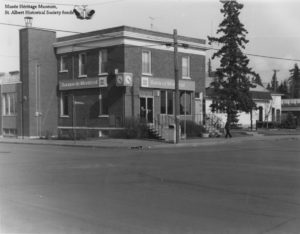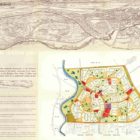Then & Now
Banking in St. Albert
July, 2017
 Your options when it comes to banking in St. Albert today are virtually unlimited. You can bank with any of Canada’s big five, with a smaller independent branch, with a credit union or even electronically through an online bank. Getting to this point, however, was a long road with a fair share of ups and downs. In fact, for many decades, there were only two options available: bank with the one operational financial institution in town, or hide your money under your mattress and hope for the best.
Your options when it comes to banking in St. Albert today are virtually unlimited. You can bank with any of Canada’s big five, with a smaller independent branch, with a credit union or even electronically through an online bank. Getting to this point, however, was a long road with a fair share of ups and downs. In fact, for many decades, there were only two options available: bank with the one operational financial institution in town, or hide your money under your mattress and hope for the best.
1910s
For St. Albert’s first 50 years, if residents wanted a bank to manage their finances for them, they had to take a trip into Edmonton and visit a bank there. But for a growing town, this was hardly ideal, so in the early 1900s, local business owners united with the goal of attracting a major financial institution to the little town on the banks of the Sturgeon River. In 1912, they achieved their goal when the French-Canadian Banque d’Hochelaga agreed to open an office in town to serve the citizens of St. Albert. It was small at first, consisting of only one small desk in a rented space on Perron Street. But that would soon change.
1920s
In 1920, the Banque d’Hochelaga office had become successful enough that it was able to transition into a full-fledged branch. A new building was even constructed to house the branch—the same building where St. Albert’s Art Gallery can be found today.
Though Banque d’Hochelaga was successful within the town, on a national scale, things looked bleak. In 1925, the company was bought by Quebec’s Banque Nationale, and St. Albert’s bank found itself under new management.
1930s
In the 30s, Canada was in the middle of the Great Depression, a time when banks all over the country were failing. The purchase of Banque d’Hochelaga by Banque Nationale had only put off the inevitable. In 1937, St. Albert’s only bank closed its doors, leaving residents without a bank for the next 18 years.
1940s
While the Great Depression had led to the temporary collapse of Canadian banks, it gave rise to a new financial institution: the credit union. St. Albert Savings and Credit Union began in the early 40s as an alternative to banking. With the absence of any banks in town, this credit union became very popular despite being open only two days a week.
1950s
By 1955, the banks had made a comeback, and the Bank of Montreal purchased the vacant Banque Nationale building downtown. Though it was the only bank in town, it still had competition from the growing credit union movement that was sweeping across the country.
1960s
In 1962, the Bank of Nova Scotia opened a branch in Grandin Mall, finally giving residents a second option when it came to banking. The next year, in 1963, these options expanded even further when St. Albert Savings and Credit Union opened a full-time office on Perron Street, which allowed them to serve their members on a more regular basis.

1970s
By the 1970s, virtually all of the cities and towns in the region had built their own credit unions, and in 1975, many of them (including St. Albert Savings and Credit Union), merged to form Capital City Savings. Capital City Savings would continue growing for the next 30 years, at which point it would undergo a rebranding and become the Servus Credit Union we know today.
Today
Banking today is incredibly stable compared to those early years. Back then, if any one branch had closed or left town, it would have crippled the city. It took over a century to attain this stability, but the effort put in by our predecessors has certainly paid off, and it will undoubtedly be enjoyed by generations to come. t8n
Fun Fact
Until 1934, currency in Canada was printed by individual banks. Early citizens of St. Albert would have had Hochelaga-branded dollars, whereas Edmontonians would have had Imperial Bank-printed ones. Everyone agreed though that a
dollar was worth a dollar, no matter where it came from.
Did You Know?
A bank is a private for-profit company run by a board of directors; a credit union is a membership-based non-profit organization where all members have an equal say in how their finances are managed.













